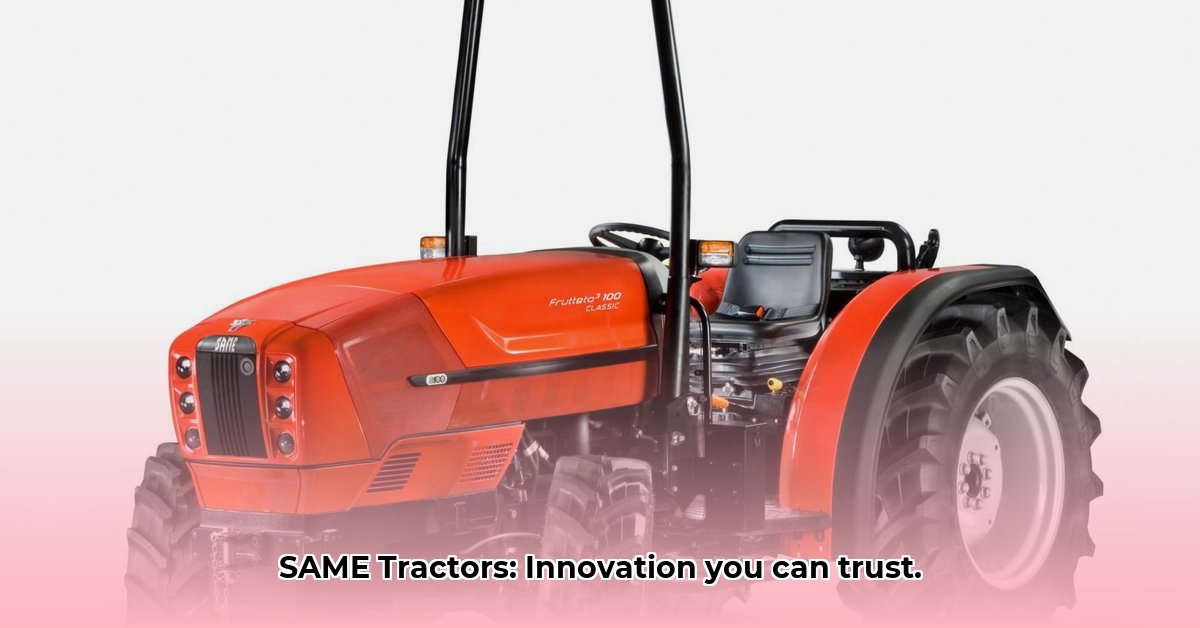
SAME Tractors: A Century of Agricultural Innovation
SAME tractors represent more than just agricultural machinery; they embody a legacy of ingenuity, resilience, and a deep understanding of the farmer's needs. This isn't simply a technical overview; it's a narrative exploring SAME's journey from its pioneering early days to its current position as a respected global player in the agricultural equipment industry. We'll delve into the key innovations that defined its success, particularly the impactful Explorer series, and examine the strategic decisions that shaped its growth. For more information on SAME's history, visit the SAME website.
Early Days: Forging a Reputation for Reliability
The official launch of SAME in 1942 marked a significant milestone, but its foundations were laid much earlier through a commitment to powerful engines and robust agricultural tools. The early air-cooled diesel engines, a technological marvel for their time, powered tractors like the DA 25 and the Centauro series. These machines weren't just built to work; they were built to endure, earning SAME a reputation for reliability that would define its legacy. This focus on straightforward maintenance proved crucial, as farmers demanded machines that minimized downtime and maximized productivity. Isn't that what matters most? Timely harvests are paramount, and reliable equipment is the cornerstone of success.
SAME's commitment to improvement extended beyond engine design. Continuous advancements in gearboxes and transmissions, evolving from simple mechanical systems to sophisticated electronic ones like the PowerShift in the Titan series, mirrored the industry’s progression. This constant evolution underscores SAME's proactive approach to meeting evolving agricultural demands, streamlining operations, and enhancing efficiency. Every innovation aimed for a simpler, more productive farming experience.
The Explorer Series: A Paradigm Shift in Affordability and Performance
The introduction of the SAME Explorer series represented a significant turning point. This wasn't just an iteration; it was a bold leap forward. The series achieved a remarkable balance: delivering impressive power and performance without the prohibitive cost often associated with such capabilities. This affordability, coupled with exceptional reliability, made the Explorer series an undeniable hit among mid-sized farms, quickly becoming a symbol of SAME's dedication to both functionality and economic viability. Its success highlighted SAME's astute understanding of the needs and priorities of the modern farmer. What was the key driver of this success? It's simple: delivering exceptional value.
Strategic Acquisitions: Expanding Reach and Expertise
SAME's success story is not solely one of technological prowess; it's also a masterclass in strategic acquisitions. The incorporation of Lamborghini Trattori, Hürlimann Traktoren, and portions of Klöckner-Humboldt-Deutz were not merely about increasing scale; they were about strategically broadening expertise, expanding market reach, and offering a more diverse product portfolio. This calculated growth demonstrates SAME’s forward-thinking approach to securing its position as a major player in the global agricultural machinery market. Shouldn't all companies strive to learn and adapt in this way?
SAME Today and into the Future: Embracing Sustainability and Technology
SAME continues to evolve, reflecting a commitment to both time-tested reliability and cutting-edge advancements. Its current product line showcases this dedication, integrating sustainable practices and innovative technologies. The future likely holds continued investment in research and development (R&D), focusing on areas like autonomous tractors and precision farming technologies. This strategy reflects SAME's commitment to remaining at the forefront of the agricultural technology revolution. What does the future hold for SAME? Continued growth and innovation are certain.
Actionable Insights: A Multi-Stakeholder Perspective
SAME's success impacts numerous stakeholders. Understanding their varied objectives provides valuable insights into the company's present and future.
- SDF Group (Owner): Focused on market analysis, R&D investment in autonomous features, and global market expansion.
- Farmers: Prioritizing cost-effectiveness, financing options, and maximizing efficiency through advanced technologies.
- Collectors: Engaging in market value tracking, networking, and historical research of classic models.
- Parts Suppliers: Ensuring reliable supply chains, sustainable sourcing, and advanced manufacturing techniques.
- SAME Dealers: Improving customer service, parts availability, and adapting to new business models.
Navigating the Landscape: Risks and Regulations
The agricultural equipment sector faces ongoing challenges. For SAME, these include securing parts, keeping pace with technological change, competing with other manufacturers, and adapting to economic fluctuations. Mitigating these requires proactive strategies. Maintaining strong supply chains, consistent R&D investments, sound financial planning, and adherence to environmental regulations (emission standards and sustainable manufacturing) are crucial for long-term success. The sector is undoubtedly dynamic, and adaptability is essential. How does SAME navigate these challenges? Through constant innovation and strategic foresight.
Comparing SAME Explorer Tractor Maintenance Costs: A Step-by-Step Guide
Understanding the total cost of ownership is crucial for any agricultural equipment purchase. This goes beyond the initial price tag; long-term maintenance significantly impacts profitability. The following steps provide a structured approach to comparing maintenance costs for SAME Explorer tractors against competitors.
- Competitor Identification: Identify comparable models from brands like New Holland, John Deere, and Kubota, considering horsepower and intended use.
- Data Gathering: Research maintenance schedules and service intervals using manufacturer websites and independent reviews.
- Parts Cost Analysis: Obtain price quotes for common replacement parts from various suppliers.
- Labor Cost Factor: Account for labor costs for routine maintenance and repairs based on local rates.
- Total Cost of Ownership Calculation: Combine parts, labor, and service intervals to estimate total maintenance costs over a set period (e.g., 5-10 years).
- Unexpected Repair Consideration: Factor in potential costs of unpredictable repairs based on the tractor's reliability.
- Warranty Evaluation: Assess warranty coverage, as this can impact initial maintenance costs.
This approach allows for a clear comparison of maintenance expenses across different tractor brands and models. Remember, lower initial costs don’t always translate to lower long-term expenditures. Thorough research is paramount.